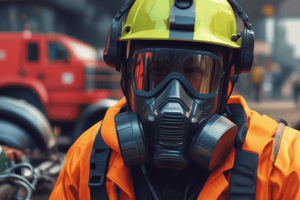Podcast
Questions and Answers
What is the primary reason to avoid using tools when distracted or under the influence of substances?
What is the primary reason to avoid using tools when distracted or under the influence of substances?
- It causes tools to wear out faster.
- It leads to tool inefficiency.
- It significantly raises the chance of injuries. (correct)
- It increases the risk of tool misuse.
Which type of personal protective equipment (PPE) is essential for preventing hearing loss when using power tools?
Which type of personal protective equipment (PPE) is essential for preventing hearing loss when using power tools?
- Gloves
- Hearing protection (correct)
- Respirators
- Eye goggles
What could lead to electric shocks while using power tools?
What could lead to electric shocks while using power tools?
- Using tools in well-ventilated areas
- Bypassing grounding features (correct)
- Maintaining tools at full speed
- Utilizing waterproof gloves
Which practice can help prevent kickback incidents when using cutting tools?
Which practice can help prevent kickback incidents when using cutting tools?
What should be done with any damaged tools before use?
What should be done with any damaged tools before use?
Why is maintaining a well-lit work area essential for tool safety?
Why is maintaining a well-lit work area essential for tool safety?
Which of the following practices should NOT be followed when using power tools?
Which of the following practices should NOT be followed when using power tools?
What is a key precaution to take regarding electrical tools when working in wet conditions?
What is a key precaution to take regarding electrical tools when working in wet conditions?
Flashcards are hidden until you start studying
Study Notes
Hand and Power Tools Safety
- Nearly half a million people are injured annually due to tool-related incidents, resulting in numerous emergency room visits and fatalities.
- Injuries can range from abrasions, muscle sprains, burns, lacerations, and amputations to long-term issues like hearing damage and repetitive stress disorders.
- Power tools can present multiple hazards simultaneously, such as cuts, eye injuries, electric shocks, respiratory problems from dust, and noise-related hearing loss.
Safe Practices Before Use
- Ensure mental focus; avoid using tools when distracted or under the influence of substances that impair judgment.
- Regularly inspect tools for wear or damage, including cracked handles, rust, or dull blades.
- Avoid using tools for unintended purposes, like using a screwdriver as a chisel or a knife as a screwdriver.
Personal Protective Equipment (PPE)
- PPE includes eye protection (goggles for high-risk tasks), respirators for dust, and ear protection to prevent hearing loss.
- Gloves should be worn to protect hands unless operating certain power tools, where they may snag.
- Adjust clothing to minimize risk; ensure hair is tied back and remove jewelry.
Electrical Safety
- One worker dies from electrocution every week in the U.S.; water increases shock risk with electrical tools.
- Do not use power tools in wet conditions, and avoid bypassing grounding features.
- Use GFCI outlets for electrical tools to reduce shock hazards.
Kickback and Material Safety
- Kickback occurs when a tool's blade binds and is thrust back toward the user; secure materials before cutting or drilling.
- Maintain tools at full speed during operations to prevent jamming and replace dull blades immediately.
- Choose materials wisely to avoid binding and kickback; avoid using wet or knotty wood.
Work Environment Precautions
- Ensure a well-lit work area to facilitate safe tool use; avoid areas with flammable materials.
- Remove flammable materials or cover them before work, as sparks can ignite them.
- Maintain a clean work area to prevent slip and trip hazards and avoid leaving tools on ladders or scaffolding.
Summary of Best Practices
- Inspect tools before use and tag any damaged tools as out of service.
- Wear appropriate PPE according to the job's risks.
- Be mindful of electrical hazards and ensure ground connections are intact.
- Keep the workspace organized to ensure safety for oneself and others.
- Utilize knowledge of tool hazards and safe practices to ensure a safe working environment.
Tool-Related Injuries
- Approximately 500,000 injuries annually from tool incidents lead to emergency room visits and fatalities.
- Injuries can vary significantly, including abrasions, lacerations, muscle sprains, burns, amputations, and long-term issues like hearing damage and repetitive stress disorders.
- Power tools can cause multiple hazards, including cuts, eye injuries, electric shocks, respiratory issues from dust, and noise-related hearing loss.
Safe Practices Before Use
- Maintain mental focus; avoid using tools when distracted or impaired by substances.
- Conduct regular inspections for wear and damage, checking for cracked handles, rust, or dull blades.
- Use tools only for their intended purpose to prevent accidents and injuries.
Personal Protective Equipment (PPE)
- PPE essentials include eye protection (goggles), dust respirators, and ear protection to mitigate hearing loss.
- Wear gloves for hand protection, but avoid wearing them with certain power tools due to snag risks.
- Ensure clothing adjustments are made to prevent entanglement; tie back hair and remove jewelry.
Electrical Safety
- Electrocution fatalities occur weekly in the U.S., notably increased by water exposure when using electrical tools.
- Avoid using power tools in wet environments and do not bypass grounding features for safety.
- Utilize Ground Fault Circuit Interrupter (GFCI) outlets to minimize shock hazards.
Kickback and Material Safety
- Kickback incidents happen when a tool's blade binds, propelling it toward the user; secure materials to prevent this.
- Tools should operate at full speed to avoid jamming, and dull blades must be replaced immediately.
- Select appropriate materials carefully to avoid kickback, steering clear of wet or knotty wood.
Work Environment Precautions
- Ensure workspaces are well-lit to avoid accidents; steer clear of flammable materials.
- Remove or cover flammable materials before work, as sparks can ignite them.
- Keep work areas clean to prevent slip and trip hazards and avoid leaving tools on ladders or scaffolding.
Summary of Best Practices
- Inspect tools before use and tag any defective tools as out of service.
- Adhere to appropriate PPE based on job-related risks.
- Stay aware of electrical hazards, ensuring all ground connections are intact.
- Maintain an organized workspace to promote safety for oneself and others.
- Leverage knowledge of tools and safety practices to create a secure work environment.
Studying That Suits You
Use AI to generate personalized quizzes and flashcards to suit your learning preferences.




